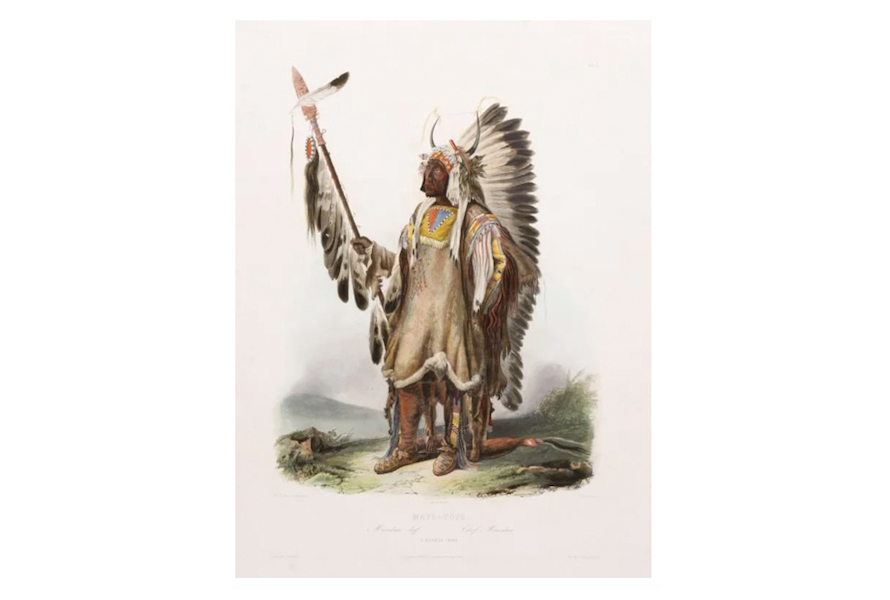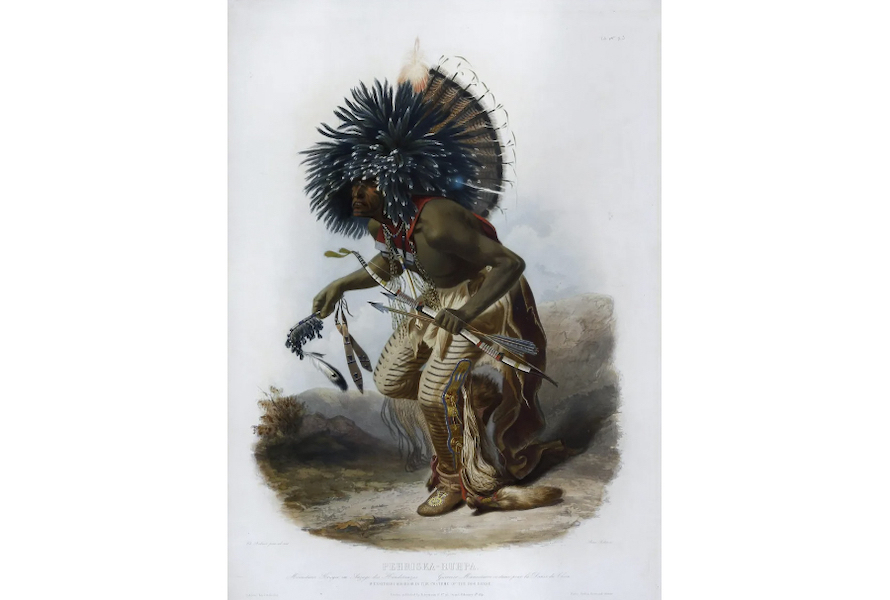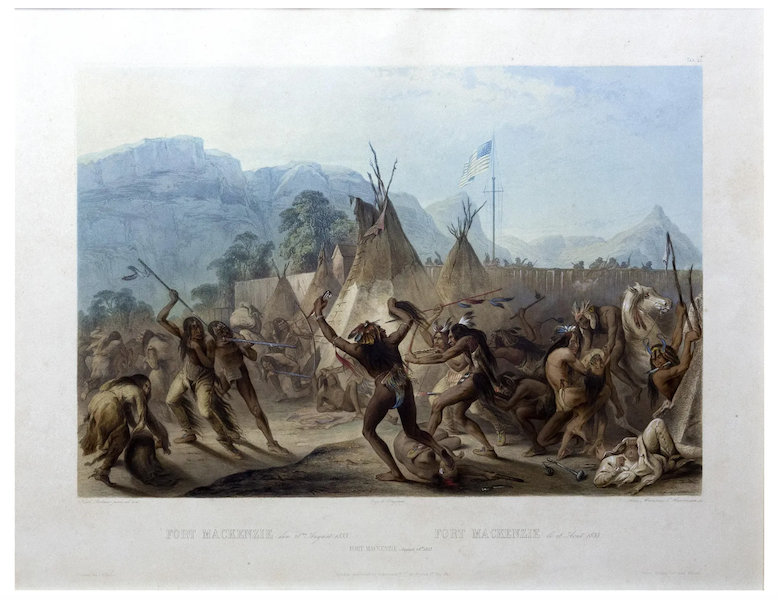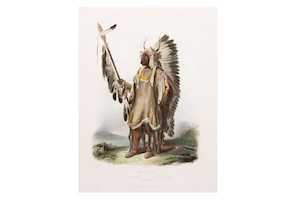
NEW YORK — In the 1800s, Karl Bodmer (Swiss, 1809-1893) was one of a handful of artists drawn to the western United States to capture on paper the indigenous people who called these majestic and untamed lands home. As the area was just beginning to be settled by Euro-American explorers, the West was a source of fascination. Artists such as Bodmer undertook long journeys to document and preserve it even as it was changing.
Bodmer was commissioned by the German naturalist and explorer Prince Maximilian of Wied-Neuwied to be the chief draftsmen for a journey of some 2,500 miles, from St. Louis to the upper end of the Missouri River, in 1833-34. Maximilian had famously explored Brazil with another artist, but apparently was not satisfied with the results, so he asked Bodmer to come to North America with him. Bodmer agreed and created watercolors of the scenes he encountered as well as portraits of indigenous people he met from groups such as the Mandan, Assiniboine, Blackfoot and Lakota.
Bodmer’s portraits of indigenous peoples accurately depicted their lives, culture, homelands and leaders. Many of the Native American nations he came across were largely unknown to non-indigenous people, except perhaps to fur traders and trappers. As time passed, the landscape — and its peoples — would be transformed by mass settlement.
According to the Amon Carter Museum in Fort Worth, Texas, which is currently displaying an exhibition of Bodmer’s artworks from this trek, he created compelling portraits of those who he met. “His attentiveness to Indigenous protocols, combined with his acute sensitivity of observation and his subtle, refined brushwork, resulted in works that offer an unparalleled level of visual detail,” the museum wrote in a press release on the exhibition.

One of Bodmer’s most renowned artworks was Pehriska Ruhpa – Moennitarri Warrior in the Costume of the Dog Danse. Fine examples of this scene have sold well at auction; a richly colored aquatint achieved $40,000 plus the buyer’s premium in October 2020 at Arader Galleries. The portrait was published in Travels in the Interior of North America, which detailed Bodmer and Wied’s journey. This framed aquatint engraving demonstrates Bodmer’s mastery in capturing the details that made his subjects so compelling, from the elaborate headdress to the beading and feathers.
At a time when the West was being colonized and indigenous peoples were being killed or forcibly removed from their homes, Bodmer tells a story of life out West that shows a more natural America than the shops, town squares and busy streets that shaped the Eastern seaboard.

While Bodmer’s colored engravings bring the most money, even pencil drawings attract collectors. For instance, Man and Shield, which was a sketch for Bison Dance of the Mandan Indians, brought $15,000 plus the buyer’s premium at Freeman’s in December 2019.
Because he spent time with the indigenous groups, Bodmer was privy to scenes few non-Native people would experience. A fine example is the hand-colored aquatint engraving titled The Interior of the Hut of a Mandan Chief, which made $8,500 plus the buyer’s premium in September 2019 at John Moran Auctioneers, Inc. This scene, which is also published in Travels in the Interior of North America, shows several men sitting around a circle surrounded by the trappings of their daily lives: horses, dogs, baskets, spears and furs.

Bodmer famously quipped that while he had acquaintances in Europe, he had friends in America, referring to the native people he befriended during the expedition. In the winter of 1833-34, Bodmer’s party overwintered near Fort Clark (in present day North Dakota) with the Mandan people, whom the artist showcased in many works. Reportedly, the Mandan often invited Bodmer to be a special guest at ceremonies and dances.
Above all else, Bodmer sought to faithfully and honestly depict the people in the portraits he created, such as in the aquatint Mato-Tope, a Mandan chief, which earned $7,000 plus the buyer’s premium in May 2022 at Garth’s Auction Inc. Mato-Tope is said to have gotten his name, which translates to four bears, after rushing the Assiniboine people during a battle with the might of four bears.

From his encampments, Bodmer witnessed interactions between native peoples and European settlers and the US military, but also among indigenous groups. Bodmer’s aquatint engraving Fort Mackenzie came into being after he saw two native groups attack a Blackfoot camp. An example of the aquatint realized $9,500 plus the buyer’s premium in June 2021 at Arader Galleries. The Montana fort was built in 1832 by a fur trader, Kenneth McKenzie, to trade with the Blackfeet who settled along the Missouri River. Bodmer and Maximilian had been encamped at the fort for less than three weeks when the attack involving nearly 600 Assiniboin and Cree warriors took place early one August morning.
Bodmer’s sketches and engravings from the expedition, from genre scenes to his powerful and sensitive portraits, literally paint a picture of what life in the West was like in the 1800s. His firsthand observations, skilled draftsmanship and brushwork recording this now-bygone era have resulted in a body of work that is as compelling as when the images were new.



